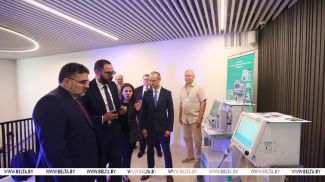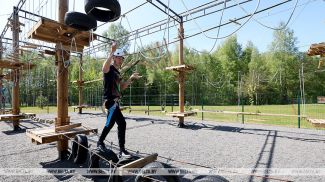The decision to build the Belarusian nuclear power plant was made in 2008. A lot has been done since then. The first unit of the Belarusian nuclear power plant became operational in 2021. It gave a new status to the country: Belarus is no longer a beginner as far as nuclear energy industry is concerned. Meanwhile, Belarus prioritizes nuclear and radiation safety. Every year the Nuclear and Radiation Safety Department of the Belarusian Emergencies Ministry (Gosatomnadzor) publishes publicly available information so that Belarusians would know what measures are taken to ensure nuclear and radiation safety. A regular review dedicated to the state of nuclear and radiation safety in Belarus was presented by Gosatomnadzor representatives in BelTA's press center.
The Gosatomnadzor consultant Oleg Sobolev noted that such reviews will be published every year from now on. “We see it as an obligation of our department to the Belarusian society, which deserves to know what is going on in the country, what the state of the facilities is, how nuclear and radiation safety is ensured, and how the country's regulatory infrastructure is organized. Let me tell you right away: it is organized in compliance with requirements of the International Atomic Energy Agency and the agency's various evaluation missions have repeatedly checked it,” he said.
Infrastructure
The first part of the review is dedicated to infrastructure, without which the operation of sources of ionizing radiation and nuclear industry installations is impossible. The infrastructure includes the regulatory framework, the work of the regulatory agency, scientific support, systems for training personnel for the industry, emergency preparedness and response.
Deputy Head of the Radioactive Waste Management Office of the Nuclear and Radiation Safety Department of the Belarusian Emergencies Ministry (Gosatomnadzor) Yekaterina Shmeleva stressed: “For 15 years with reliance on International Atomic Energy Agency recommendations and taking into account the experience of other countries persistent work was done to form and develop the regulatory infrastructure. National legislation and approaches to oversight efforts were improved persistently, nuclear laws and regulations grew. Effective systems for licensing and permitting activities were built. Our country demonstrates solid adherence to principles of ensuring of nuclear and radiation safety.”
Nuclear installations
The second part of the review covers the state of various nuclear installations and facilities. The Belarusian nuclear power plant is number one. There are also nuclear installations in the energy and nuclear research institute Sosny of the National Academy of Sciences of Belarus and other organizations.
Close attention is always paid to the safe operation of nuclear installations. “Over the course of 15 years we've managed to implement into our oversight model all the tools the International Atomic Energy Agency recommends to countries with a nuclear energy program. Moreover, we've been evaluated by an IAEA mission, which confirmed this fact. The tools include the organization of scheduled and off-schedule inspections, the legislated right to get free access to any part of the facilities we oversee but certainly while observing occupational safety and health rules. Apart from that, our inspectors face no restrictions with regard to the organization of oversight events and their scope,” stated Head of the Office for the Organization of Oversight over Nuclear and Radiation Safety of Nuclear Installations of the Nuclear and Radiation Safety Department of the Belarusian Emergencies Ministry (Gosatomnadzor) Maksim Mazurenko.
Gosatomnadzor oversees absolutely all the steps and stages of commissioning of power-generating units. “Permanent oversight mode has been legislated. In this mode our inspectors are constantly present at the nuclear power plant site. We've noticed no critical violations, which could have influenced radiation safety one way or another,” Maksim Mazurenko pointed out.
The review also contains information about the state of sources of ionizing radiation. In Belarus there are over 1,700 organizations that operate over 24,000 sources of ionizing radiation. “More than 80% of them are used in healthcare. Those are mainly x-ray diagnostics machines. Sources of ionizing radiation are also used in the manufacturing sector and in science. They are increasingly frequently used for examinations. For instance, there are x-ray machines for examining the luggage of metro passengers. Vehicle inspection units are placed at customs clearance stations. So sources of ionizing radiation are very versatile. This is why legislation has been passed to classify them according to the degree of radiation hazard. This differentiated approach is also used in oversight activities. Oversight measures are commensurate with the degree of radiation hazard,” noted Irina Tkachenok, Head of the Department for the Organization of Oversight over Radiation Safety of Sources of Ionizing Radiation of the Nuclear and Radiation Safety Department of the Belarusian Emergencies Ministry (Gosatomnadzor).













